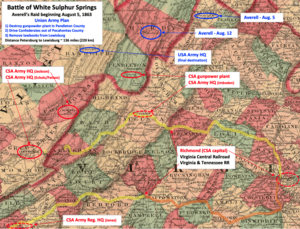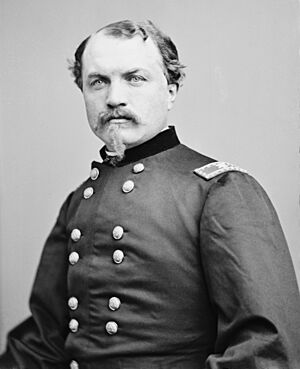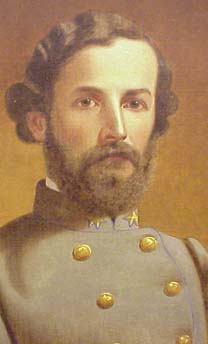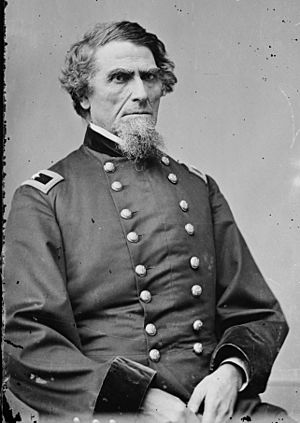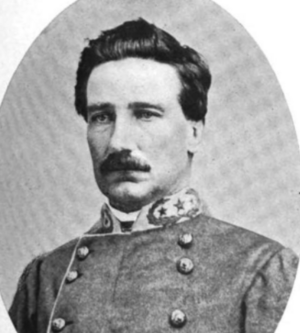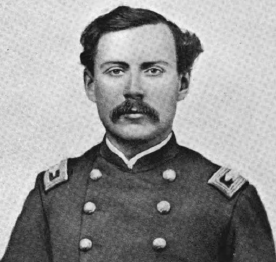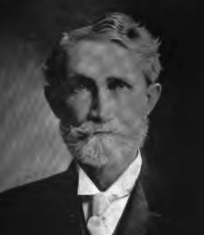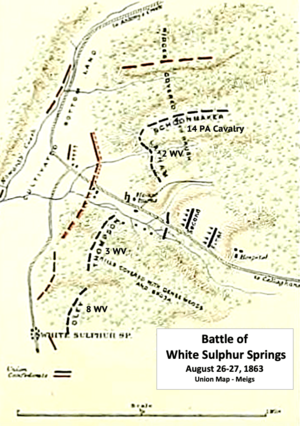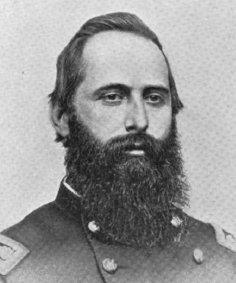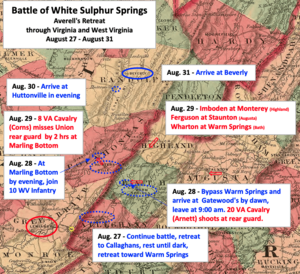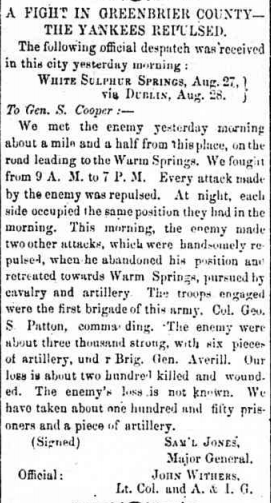Battle of White Sulphur Springs facts for kids
Quick facts for kids Battle of White Sulphur Springs |
|||||||
|---|---|---|---|---|---|---|---|
| Part of the American Civil War | |||||||
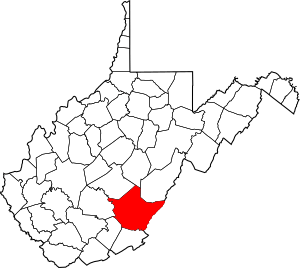 Greenbrier County, West Virginia |
|||||||
|
|||||||
| Belligerents | |||||||
| Commanders and leaders | |||||||
| Units involved | |||||||
|
|
||||||
| Strength | |||||||
| ~ 1,300 | ~ 2,300 | ||||||
| Casualties and losses | |||||||
| 218 (26 killed, 125 wounded, 67 captured) | 162 (20 killed, 129 wounded, 13 missing) | ||||||
The Battle of White Sulphur Springs was a fight during the American Civil War. It happened in Greenbrier County, West Virginia, on August 26 and 27, 1863. In this battle, a Confederate force led by Colonel George S. Patton won against a Union group. The Union group was commanded by Brigadier General William W. Averell.
West Virginia had only become a state a few months before this battle. People living near the state's southern border were divided. Some supported the Union, and others supported the Confederacy. Many soldiers on both sides were from West Virginia, including counties close to the battle site.
This battle was important for the Union's plans. Averell was leading his first of three trips into Confederate areas in 1863. His goals included destroying a saltpeter (a material for gunpowder) factory. He also wanted to defeat a Confederate cavalry group and capture law books from the Virginia Supreme Court library. Confederate leaders worried Averell wanted to destroy important railroads. These railroads helped the Confederacy move supplies and soldiers. One railroad even served a lead mine that made bullets for the army. Patton's Confederate force stopped Averell's Union group near White Sulphur Springs. This place was about 10 miles (16 km) east of Lewisburg, West Virginia.
Both sides attacked many times, but neither gained much land. The Union force could not reach Lewisburg. They had to make a difficult retreat north, with Confederate forces chasing them. The Confederate victory showed that Patton could lead a large group of over 2,000 men well. It also saved the law library in Lewisburg, though the Confederates didn't know this at the time. Averell did achieve two of his three goals. His newly mounted soldiers also learned a lot about fighting in the mountains of West Virginia. The law books were never captured by the Union. They were later moved to Richmond, Virginia.
Contents
Why the Battle Happened
West Virginia's Story
The American Civil War began in April 1861. Before that, seven southern states left the United States. They formed the Confederate States of America. Four more states, including Virginia, joined them later. On April 17, 1861, Virginia decided to leave the United States.
However, many people in the western part of Virginia stayed loyal to the United States. In June 1861, they met and decided to form their own state government. This new state officially became West Virginia on June 20, 1863.
West Virginia had rough land, few good roads, and not many towns. It also had less money than nearby states. Even though Union troops were in charge of much of western Virginia in 1861, many were sent east in 1862. This allowed Confederate soldiers to operate in West Virginia in 1863. Not everyone in West Virginia supported the Union. Some people, called "bushwhackers" or "Partisan rangers," used surprise attacks to try and control the state. Many mountain people supported the Union, while most people in the large valleys supported the Confederacy. About 20,000 to 22,000 West Virginians fought on each side of the war. Lewisburg, a town in West Virginia near the Virginia border, supported the Confederacy.
Important Railroads
About 20 percent of the Confederacy's railroads were in Virginia. The Confederate capital city, Richmond, had railroads coming in and out from all directions. The Virginia Central Railroad was 200 miles (320 km) long. It ran from Richmond deep into the western part of the Shenandoah Valley. This railroad moved soldiers and brought raw materials to cities like Richmond.
Another key railroad was the Virginia and Tennessee Railroad. It was close to West Virginia's southern border. This railroad helped the Confederacy move troops and supplies. It connected to other railroads in Lynchburg, Virginia and Bristol, Tennessee. It also had telegraph wires along its line. Important salt and lead mines were located near Wytheville, Virginia, along its route. The lead mine provided about one-third of the lead used by the Confederacy for bullets. In July 1863, a Union cavalry raid tried to damage this railroad and reach the mines, but it failed.
Union Commander Averell
Brigadier General William W. Averell was a graduate of West Point. He was an excellent horseman and had fought in New Mexico. Early in the Civil War, he trained the 3rd Pennsylvania Cavalry Regiment. His men thought he was a great trainer. He was promoted to brigadier general in September 1862.
In May 1863, Averell was put in charge of the Fourth Separate Brigade in West Virginia. Historians disagree if this was a punishment or because he was good at training cavalry. The Union Army in West Virginia needed to move faster to fight Confederate cavalry. Averell took command on May 23. He changed the 2nd, 3rd, and 8th West Virginia infantry regiments into mounted infantry. This meant they would ride horses. He sent these regiments to a training camp and tried to get them equipment like horseshoes and ammunition.
Kelley's Orders for Averell
Brigadier General Benjamin Franklin Kelley was the commander of the Union Army in West Virginia. On August 12, 1863, Kelley ordered Averell's brigade into West Virginia. Averell was near Moorefield, West Virginia at the time. His orders were to go to Huntersville, West Virginia, and drive out the Confederate force there.
Another goal was to attack a saltpeter and gunpowder factory in Pendleton County, West Virginia. Finally, he was to go to Lewisburg, West Virginia. There, he was to remove any enemy forces and take the law books from the Virginia Supreme Court library. Kelley said these books belonged to the new state of West Virginia and its judges needed them.
Averell was told that two of his regiments would meet him at Huntersville. He was also told that another Union force might help him at Lewisburg. Averell's brigade could only carry 10 days of food, so they would have to find food from the land. He also had to get horses for his artillery by taking them from landowners.
The Armies Fighting
The Battle of White Sulphur Springs mostly involved units from West Virginia and Virginia. Some Confederate soldiers were from Greenbrier County, West Virginia, where the battle took place. Others were from nearby counties. For example, Company G of the 26th Virginia Infantry Battalion was from White Sulphur Springs. They were known as the White Sulphur Rifles.
Union Army Forces
Benjamin Franklin Kelley was the overall commander for the Union Army in West Virginia. He did not fight in this battle, but he was Averell's boss. Averell's group, the 4th Separate Brigade, was spread out. For the battle, Averell had about 1,300 men. His force included the 2nd, 3rd, and 8th West Virginia mounted infantry regiments. He also had the 14th Pennsylvania Cavalry Regiment, Gibson's Cavalry Battalion, and six artillery guns.
The 2nd West Virginia Mounted Infantry joined Averell in Huntersville on August 23. They had more ammunition than the rest of Averell's group and shared some. The Union soldiers mostly used breech-loading carbines, which were rifles that loaded from the back.
Confederate Army Forces
In August 1863, the Confederate Army controlled much of the Greenbrier Valley in West Virginia. Major General Sam Jones was the overall Confederate commander for the area. He was not in the battle, but the soldiers and land were his responsibility.
Brigadier General John Echols usually commanded the brigade in Lewisburg. But he was away in Richmond. So, Colonel George S. Patton commanded the brigade during the battle. Patton had about 2,300 men. His main units were the 22nd Virginia Infantry Regiment, the 26th Virginia Infantry Battalion, the 45th Virginia Infantry Regiment, and Chapman's Artillery.
Moving Towards Battle
In July 1863, most of Averell's brigade was involved in small attacks on General Robert E. Lee's army. Lee's army was retreating from the Battle of Gettysburg in Pennsylvania. Averell's brigade then moved to Winchester, Virginia on July 30.
Through Hardy County
On August 5, 1863, Averell left Winchester and moved west into Hardy County, West Virginia. He arrived at Moorefield that evening. Averell's scouts had small fights with Confederate groups. After a few days, the brigade moved to Petersburg. Many people in eastern Hardy County supported the Confederacy. But people in the west, like Petersburg, were more loyal to the Union.
Averell needed supplies and waited in Petersburg. There, he received Kelley's orders about the gunpowder factory, Huntersville, and Lewisburg. He also learned that some supplies were coming, but no horses for his artillery. This meant he had to take horses from local landowners. During this time, local bushwhackers often attacked Averell's force. They used quick attacks to weaken the Union soldiers. Two Union soldiers were killed and four wounded by these attacks. A local pro-Union group, the "Swamp Dragons," helped fight off the guerrillas.
Into Pendleton County
Averell received some supplies on August 17, but no ammunition for his small guns. Still, he decided to start his mission. The next day, he sent some of his men south towards Franklin, West Virginia. Other groups went on different routes. On August 19, Averell moved close to Franklin. From there, two groups of soldiers destroyed the saltpeter factory about 5 miles (8 km) south. The next day, Averell moved southwest towards Monterey, Virginia.
Through Highland County
The trip from Franklin to Huntersville went through Highland County, Virginia. Bushwhackers constantly attacked Averell's group. The 14th Pennsylvania Cavalry fought them all day. Averell stopped at Monterey on August 20. He learned that Confederate generals had been there the day before, planning to attack him. The Union brigade left early on August 21, moving southwest towards Huntersville.
By now, Confederate leaders had been watching Averell for over a week. They first thought he was going to attack Staunton, Virginia, which had an important railroad stop. But Robert E. Lee thought Averell's real targets were Huntersville and Lewisburg. On August 21, Confederate General Jones moved his troops, thinking Averell was going east to Staunton. He also asked Lee for more troops.
Reaching Huntersville
Averell moved towards Huntersville in Pocahontas County, West Virginia. His lead group got within 5 miles (8 km) of Huntersville before stopping for the night. Bushwhackers again used hit-and-run attacks. Confederate soldiers attacked Averell's wagons. His lead group also pushed back about 300 of Confederate Colonel Jackson's men. Averell reported four men wounded and six horses killed that day.
On the night of August 21, Averell learned that Confederate soldiers were waiting in a ravine near Huntersville. The next day, Averell sent one group on a "false advance." The main part of his force took a different road and reached Huntersville without a fight. Jackson realized he was outflanked and moved east. Averell sent his men after Jackson. They captured Jackson's camp, burning buildings, wagons, supplies, and weapons. They kept some items like canteens and hospital supplies. August 23 was spent waiting in Huntersville for more Union regiments to arrive.
Warm Springs and Callaghan's
On August 24, Averell's brigade moved towards Warm Springs, Virginia. They arrived after dark, traveling 25 miles (40 km) from Huntersville. Averell wanted Confederate leaders to think he was targeting Confederate supply points near Staunton. Jackson was chased back to Millboro. During this movement, bushwhackers attacked Averell's front. Averell captured over 100 horse bridles and saddles, which he burned. Averell decided he could not catch Jackson. He sent one regiment back to Huntersville. Confederate leaders now feared a raid on the Virginia and Tennessee Railroad and took steps to protect it.
On August 25, Averell quickly moved his force 25 miles (40 km) to Callaghan, Virginia. On the way, they destroyed another saltpeter factory. After arriving at Callaghan's, scouting parties were sent out. They captured Confederate wagons and destroyed another saltpeter factory. On the same day, Confederate General Jones sent Patton's Brigade north, hoping to trap Averell. Later, Jones thought Averell was heading to Staunton and changed Patton's route. But then Jones learned Averell was moving to Callaghan's. So he changed Patton's destination again. Patton received Jones' message at 2:00 AM on August 26 and hurried back to Lewisburg. Jones started a race against Averell to an intersection near White Sulphur Springs, east of Lewisburg. Patton would come from the northeast, and Averell from the southeast. If Averell got past the intersection first, there would be no major Confederate force between him and the railroad.
The Battle Begins
Edgar Starts the Fight
Patton's brigade marched for almost 24 hours straight to find Averell. His lead group, the 26th Virginia Infantry Battalion, reached a road junction on the morning of August 26. This was just ahead of Averell. The 26th Virginia was led by Lieutenant Colonel George M. Edgar. Edgar's men quickly built a rough barricade on the road using nearby fences. His battalion had eight companies, split evenly on each side of the road. One company moved forward and occupied a house. They started the battle by firing at Averell's lead group around 9:30 AM.
Edgar's main job was to block the road until more of Patton's men arrived. Edgar thought his battalion was facing a huge Union force of at least 4,000 men. This was much larger than Averell's actual size of about 1,300 men. He felt better when Chapman's Battery, located on a hill behind him, started firing at the Union soldiers. The artillery fire and Edgar's first shots pushed back Averell's lead group. This held Averell's brigade long enough for Patton to get his men into a battle line.
Averell's brigade had moved about 12 miles (19 km) west from Callaghan's. Then Averell got a message from his lead group asking for more soldiers. Averell sent more men forward and started moving the rest of his command through a narrow valley. His column was 4 miles (6 km) long. Part of Ewing's Battery was brought forward and immediately started fighting.
Battle Lines Formed
Patton placed the 45th Virginia Infantry Regiment on his right side. He put the 22nd Virginia Infantry Regiment on his left. The 45th Virginia used 100 men to extend their battle line and take a small hill. Averell placed the main part of the 8th West Virginia on his left (Patton's right). The 2nd West Virginia took the right side of the road. As the day went on, Averell had Gibson's Cavalry Battalion, the 14th Pennsylvania Cavalry, the 2nd West Virginia, and three companies of the 3rd West Virginia on the right side of the road. On his left, he had the rest of the 3rd West Virginia and the 8th West Virginia.
Along the road, Ewing had two artillery guns that were not well protected until more Union soldiers arrived. Ewing used "canister" (a type of artillery shot like a giant shotgun shell) to defend against Edgar's Battalion. While looking for better places for his guns, Ewing was badly wounded. Another officer, Lieutenant Howard Morton, took command when Ewing passed out. An artillery duel between Morton and the Confederates lasted over 2 hours. The Confederate artillery leader had four guns. One of his guns was hit twice by Union artillery. Three of his four guns eventually had to be pulled back for repairs. By the end of the battle, Ewing's Battery lost one gun, ran out of ammunition, and had 16 casualties. Ewing's wound was so bad he had to be left behind with the enemy.
Constant Fighting
Averell brought the 2nd West Virginia and 14th Pennsylvania Cavalry to the right side of the road. Patton added more troops around 10:00 AM. A soldier from the 3rd West Virginia wrote that for the next four or five hours, there was "almost incessant fire" from artillery and muskets. Neither side gained an advantage.
Averell tried attacking from all sides. On the right side of the road, the 2nd West Virginia attacked the 22nd Virginia but failed. Many of the attackers were wounded very close to the Confederate line. The leader of this attack was Major Francis P. McNally. He was badly wounded and captured. The 2nd West Virginia was in an open spot. So, Averell had part of the 14th Pennsylvania Cavalry make a mounted charge on the road. Even though they reached the Confederate barricades, they were surprised by fire from enemy troops hidden in a cornfield. The fighting at the barricades was hand-to-hand. Confederates used muskets and bayonets, while Union cavalry used sabers. Captain John Bird, who led the charge, was wounded, captured, and sent to Libby Prison. Over 100 men from the 14th Pennsylvania Cavalry were killed, wounded, or captured. This was almost half of all Union casualties. During the cavalry fight, the 2nd West Virginia was able to move back to a safer spot. Morton's artillery eventually cleared the cornfield with canister shots.
On Averell's left, the 3rd West Virginia, led by Lieutenant Colonel Francis W. Thompson, made seven charges. Further left, the 8th West Virginia attacked a small hill held by 100 men from the 45th Virginia. The Confederates pushed back the attackers. Colonel Browne and the rest of his regiment joined the fight on the small hill. They kept pushing back Union attacks. Browne later reported that they "repulsed eight separate and distinct charges." During many charges, Union soldiers got as close as 20 steps from the Confederate line. Two Union officers were killed while charging. Another officer was badly wounded. Captain von Köenig, Averell's "most daring scout," was killed around 5:00 PM while looking for another officer.
After the cavalry charges, Averell heard that ammunition was running low. He thought the Confederates were also low on ammunition because their firing slowed down. The fighting stopped at nightfall. All remaining ammunition was given out. Averell decided he could not reach Lewisburg without help. He chose to wait until morning to retreat, in case more Union troops arrived or Patton retreated. Every man was brought to the front line, and they slept with their weapons ready. The Confederates tried to surprise the sleeping soldiers at least once but failed. More Confederate soldiers arrived around 2:00 AM on August 27. Patton moved some of them to the front line.
Morning Retreat
The battle started again around daybreak on August 27. The Union force could not break the Confederate line. At dawn, the 45th Virginia pushed back another Union attack. Around 9:00 AM, the fiercest fighting moved to the Union left side. During the fighting, Averell got his wagons and ambulances ready to leave. Trees were partly cut so they could easily fall across the road after his troops passed. At 10:30 AM, Averell gave the order to retreat. His force was moving towards Callaghan's 45 minutes later.
As Averell's troops pulled back, trees were knocked across the road. This created a barrier between the two armies. Morton's Battery G waited with double-shotted canister, their last ammunition. When Patton's men came forward with their "Rebel yell," the battery fired at them. Then they left quickly on fresh horses. More trees were added to the road. Then Averell's rear guard fired at the Confederates from behind the trees.
Retreat and Chase
Patton ordered Colonel Corns and the 8th Virginia Cavalry to chase Averell's retreating brigade. He used an artillery gun to clear the first of Averell's roadblocks. Further down the road, Corns found that another blockade was too hard to remove quickly. Averell's brigade reached Callaghan's about 5:00 PM on August 27. They had a short rest and a meal. After dark, they left fires burning to trick the enemy. The Union brigade then left on the road to Warm Springs. They avoided Warm Springs and took a hidden road. Then they moved to the main road between Warm Springs and Huntersville. From there, they went west to a place called Gatewood's, arriving at sunrise on August 28. Corns, who was chasing them, started again at 5:00 AM on August 28.
Averell had left Gatewood's at 9:00 AM on August 28, heading towards Huntersville. He was far from Corns, but other Confederate forces were still chasing him. Colonel William Arnett and the 20th Virginia Cavalry fired on Averell's rear guard and chased them. Despite many attacks by guerrillas, Averell's brigade arrived at Marling's Bottom that evening. There, Colonel Thomas Harris and the 10th West Virginia Infantry were waiting. Corns arrived at Gatewood's before 10:00 PM that evening. He thought he could have caught Averell if Jackson had blocked the road. The next day, Corns arrived north of Huntersville. He found he had missed Averell's rear guard by two hours. At that point, his horses were tired, so he stopped the chase.
Averell's brigade moved north to Big Spring in Pocahontas County. They continued north at 2:00 AM on August 30. They cut through a blockade on August 30 and arrived at Beverly on August 31. Averell's report described his retreat as orderly. However, leaving wounded soldiers behind, marching at night, blocking roads, and leaving fires to trick the enemy show that he was worried about his brigade's safety. A soldier from the 2nd West Virginia Infantry called the retreat "a hard, trying march." He also said they were "mercilessly bushwhacked."
What Happened After
Battle Casualties
The road from Callaghan's to the battle site was "strewn with dead and wounded soldiers." Two houses by the road were used as hospitals for both sides. Amputations (removing limbs) were done at one house. Arms and legs were piled as high as the window sills.
Averell reported that 26 Union soldiers were killed, 125 wounded, and 67 captured or missing. This was a total of 218 casualties. The 14th Pennsylvania Cavalry had 102 of these casualties. Averell also said that 2 officers and 55 wounded men were left with the Confederates because their wounds were too severe to move them. Patton reported that 117 Union soldiers were captured.
Patton reported 20 Confederate soldiers killed, 129 wounded, and 13 missing. This was a total of 162 casualties. This number does not include any casualties for the 8th Virginia Cavalry, who did not fight on the first day. The 22nd Virginia Infantry Regiment had the most casualties, with 79. Averell reported capturing 266 prisoners during his entire trip.
Impact of the Battle
A Confederate officer wrote that the Battle of Dry Creek (another name for this battle) was "one of the hottest" for the number of soldiers involved. He said it was fought very stubbornly. He also said it "turned back Averell's army" and saved a large area of valuable land from Union attacks for many months.
With his Confederate victory, George Patton showed he could lead a whole brigade on his own. He handled all attacks well and used his artillery effectively. His defeat of Averell also meant that Confederate General Sam Jones could move his troops to East Tennessee to help fight a Union army there.
William W. Averell could not get past Patton's Confederate forces. The law books he wanted were never captured. Soon after the battle, the Lewisburg law library was sent to Richmond. Averell did achieve one goal: destroying the saltpeter factory in Pendleton County. He also destroyed the Confederate Camp Northwest, including buildings, wagons, supplies, and weapons. Another saltpeter factory in Virginia was also destroyed. The fact that his brigade escaped from deep inside Confederate territory showed his skill. This trip was the start of Averell changing the Union Army in West Virginia. His brigade began as mostly infantry soldiers who knew little about military moves. He trained them in cavalry tactics, and three infantry regiments eventually became cavalry regiments. One officer wrote that Averell's brigade became "a terror to the enemy."
The Battlefield Today
As of 2011, not much of the battlefield remains. The valley part of the battlefield is now a shopping area. Interstate 64 runs through another part. Three small monuments are near a fast food restaurant. One monument, called "Dry Creek Battle," remembers the battle. Next to it is a small monument to Baron Paul von Köenig, a Union officer killed in the battle. This monument was put up in 1914 by Colonel James M. Schoonmaker, who led the 14th Pennsylvania Cavalry in the battle. In the 1990s, a group of Civil War re-enactors placed a third monument next to the first two. Across a small creek, near a gas station, there is a historical marker. It was put up by the West Virginia Historic Commission in 1963 and is titled "Dry Creek Battle."



